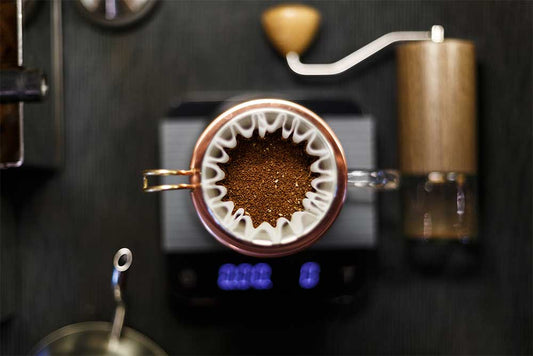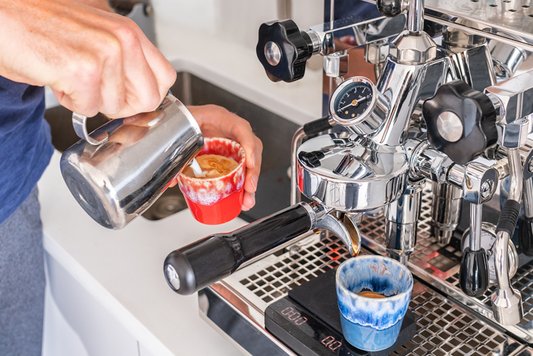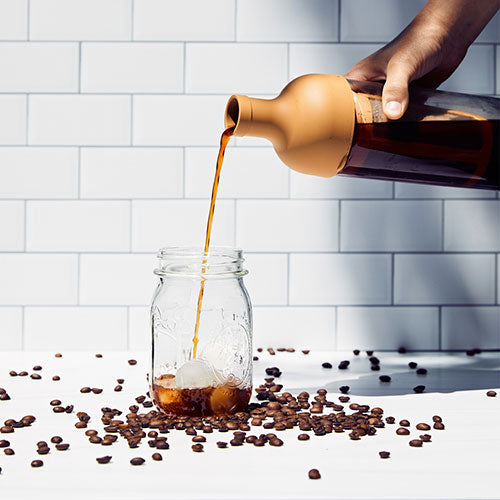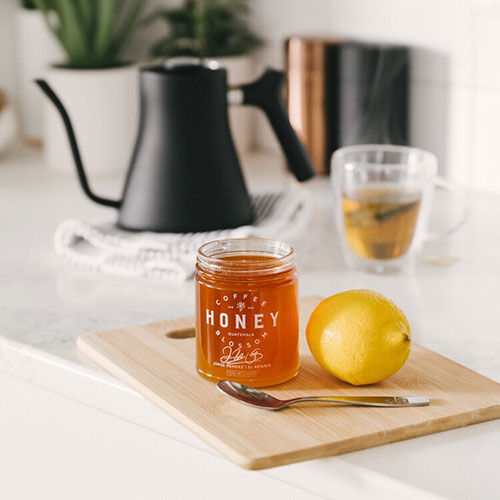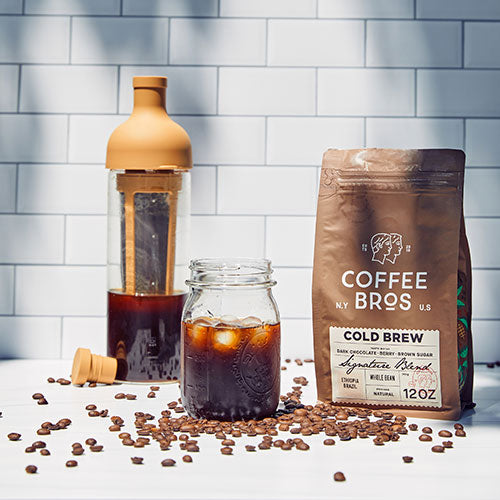Coffee to Water Ratio Calculator
| Ounces of water | Grams of water | Ml of water |
| 8 | 226 | 236 |
| Light Roast: | 199 - 205°F |
| Medium Roast: | 194 - 200°F |
| Dark Roast: | 188 - 194°F (even cooler works) |
| Autodrip | Medium-fine |
| Pourover | Medium-fine |
| Chemex | Medium-fine |
| FrenchPress | Coarse |
| Aeropress | Medium-fine |
| Mokapot | Fine |
| Siphon | Medium-fine |
| Cold Brew | Coarse |

| Brew Device | Autodrip |
| Total water | 1 cup, 8 oz, 227 g, 237 ml |
| Water Temperature | 194 - 200°F |
| Brew Ratio | 1:17 |
| Total ground coffee | 13.61 grams |
| Brew Length | 5 minutes |
How to use the Coffee Brew Calculator?
We’ve created a simple 5-step tool to calculate coffee to water ratio across 8 of the most popular brewing methods.
Step 1: Choose your coffee brewing method (pour-over, AeroPress, etc.) and your intended drink size. For this exercise, choose your selection in “cups” first and then note the corresponding values in ounces, grams, or ml of water.
Step 2: Choose the strength of your brew from mild to robust. The mild brew selection for auto drip, pour-over, Chemex, and AeroPress follow the SCA Golden Cup Standard recommendations. All other suggestions are based on our experience and preference and are great starting points for each brew type.
*Please note, all brewing ratios are in grams; 1 gram of coffee to “x” grams of water.
Step 3: Note the intended grind size for each brew type. These are general suggestions for your coffee grinder, as your ideal brew length (in total time) will alter your grind settings.
Step 4: Select your ideal brew length with shorter timed brews equating to a mild cup, while longer brew lengths will move you toward the robust and bold. Significant impact on brewing length comes from grind size, coffee or roast type, and brewing method. Your ideal brew length is one factor that needs testing to get right, as every coffee will not brew the same with all the same inputs.
Step 5: Take a snapshot of your brew recipe and give it a go!
Coffee Ratios
Pour-over coffee to water ratio
We recommend three coffee-to-water ratios for a pour-over depending on whether you want a mild, average, or robust cup of coffee.
Mild: 1:18 or the SCA Golden Cup standard
Average: 1:16
Robust: 1:13
*Use our coffee calculator for the exact measures, and please note that all ratios are 1 gram of coffee to “x” grams of water.
French press coffee to water ratio
We recommend three coffee-to-water ratios for a French Press depending on whether you want a mild, average, or robust cup of coffee.
Mild: 1:18 or the SCA Golden Cup standard
Average: 1:15
Robust: 1:13
*Use our coffee calculator for the exact measures, and please note that all ratios are 1 gram of coffee to “x” grams of water.
Chemex coffee to water ratio
We recommend three coffee-to-water ratios for a Chemex, depending on whether you want a mild, average, or robust cup of coffee.
Mild: 1:18 or the SCA Golden Cup standard
Average: 1:16
Robust: 1:13
*Use our coffee calculator for the exact measures, and please note that all ratios are 1 gram of coffee to “x” grams of water.
Autodrip coffee to water ratio
We recommend three coffee-to-water ratios for an Autodrip, depending on whether you want a mild, average, or robust cup of coffee.
Mild: 1:18 or the SCA Golden Cup standard
Average: 1:17
Robust: 1:13
*Use our coffee calculator for the exact measures, and please note that all ratios are 1 gram of coffee to “x” grams of water.
Moka Pot coffee to water ratio
We recommend three coffee-to-water ratios for a Moka Pot, depending on whether you want a mild, average, or robust cup of coffee.
Mild: 1:9
Average: 1:8
Robust: 1:6
*Use our coffee calculator for the exact measures, and please note that all ratios are 1 gram of coffee to “x” grams of water.
Siphon coffee to water ratio
We recommend three coffee-to-water ratios for a Siphon, depending on whether you want a mild, average, or robust cup of coffee.
Mild: 1:9
Average: 1:8
Robust: 1:6
*Use our coffee calculator for the exact measures, and please note that all ratios are 1 gram of coffee to “x” grams of water.
Coffee Brewing 101
What are coffee brewing ratios?
Coffee brewing ratios are the number of coffee grounds in grams to water in grams used as a starting point across all coffee brewing methods.
The Specialty Coffee Association recommends a 1:18 coffee-to-water ratio as their Golden Cup Standard for many brewing methods like pour-over, French Press, Chemex, and Autodrip.
What is the ideal coffee brewing temperature?
The optimal coffee brewing temperature for hot coffee ranges between 197 – 20 degrees, regardless of the brewing method used.
The ideal scenario would be to use a kettle with a thermometer. However, the alternative approach is boiling water and letting it sit for 30 seconds to 1 minute to reach the ideal brewing temperature.
Water temperature has a significant impact on the final result in your cup. Coffee brewed too hot might result in bitter or “burnt” tasting coffee, while coffee brewed too cool may be flat and thin.
What is the ideal brewing tempreature for Light Roast Coffee?
The ideal brewing temperature for Light Roast Coffee is right off boil or between 203 – 212 degrees Fahrenheit. The higher temperatures help prevent sourness, and high acidity is lighter roasted coffees.
What is the ideal brewing tempreature for Medium Roast Coffee?
The ideal brewing temperature for Medium Roast Coffee is about 30 seconds off boil or between 194 - 203 degrees Fahrenheit. The moderate brewing temperature helps keep the medium-roasted coffee balanced and rich.
What is the ideal brewing tempreature for Dark Roast Coffee?
The ideal brewing temperature for Dark Roast Coffee is about 1 minute off boil or between 185 – 195 degrees Fahrenheit. The lower temperature helps to rid bitterness and highlight the sweetness in the dark roasted coffee.
How to brew the perfect cup of coffee?
The three most important factors across any brewing method are time, temperature, and ratio (coffee to water). Without understanding each one of these pieces, you will be playing a guessing game on why your coffee is not coming out the way you intended.
Time:
The time corresponds to the time it takes to reach your recipe’s end weight. For example, if you are brewing a 12oz (340g) pour-over, your goal should be to finish brewing in or around 3 minutes. Please note that 3 minutes is average, but it does not mean you should be shooting for 3 minutes on every brew. Testing anywhere between 2:30 – 4:00 minutes will give you vastly different results. We often brew two coffees at the extremes and then adjust to our preference.
There are a few parts of brewing a pour-over that impact your total time.
1) Grind Size: The grind size matters across all methods and will impact your coffee’s total brewing time. Finer ground coffee will brew much slower (and may choke your brewer) than one that is ground coarser. We often shoot for a medium coarse ground coffee when brewing for pour-over, but slight adjustments may be needed.
2) Pouring frequency and method: The way you pour your water into the brewing vessel makes a big difference. Stick to a planned frequency (pouring “x” grams every 15 – 30 seconds) and then your grind size if your brew comes out too slow or fast.
We often suggest pouring water into your brewer once the water is roughly 1cm above the coffee grounds. Doing this will keep an even and consistent flow, and you repeat this process until you reach your final brewing weight.
Temperature: Temperature refers to the temperature of the water leaving your kettle and into your brewing device, such as a Fellow Stagg [XF] brewer.
We suggest starting at 208 – 212F (right off boil) and then letting the water sit for about 30 seconds to one minute before you start your first pour.
Like any brewing method, the temperature you brew your coffee can significantly impact how the coffee tastes in the cup. If brewing a darker espresso, consider lowering the temperature below 200 - 205 to offset any bitterness. A lighter roast coffee will do well at higher temperatures.
You should also test brewing your coffee at a consistent temperature versus pouring your water after it reaches 205 and letting it cool as you brew. You
will need a kettle like the Stagg EKG to display and hold a temperature. Test brewing your coffee at a consistent 200 – 205 versus letting the water slowly cool as you brew.
As always, make one change at a time, record what works and what doesn’t, then move on to the next factor.
Brew Ratio or Recipe:
Finally, your brew ratio (coffee grounds to water) is another significant factor to watch out for when making a pour-over.
You will see suggestions ranging from 1:13 up to 1:18. We tend to brew on the lower side at 1:13 – 1:15 (more coffee to water), but we know that is only a preference and not written in stone.
Example of brewing ratios:
Start with the amount of coffee you want to drink; a 12oz cup equals 340g of water. Next, pick your brew ratio; the lower the ratio, like 1:13 or 1:15, the stronger the cup of coffee will be.
Finally, divide 340g of water by 15, and you will get the number of grams of coffee to use for a 1:15 brewing ratio, ~23g. While this is not a full tutorial on brewing the perfect pour-over, we think this is a great start!
The top 8 tips for brewing a better cup of coffee
Brew with fresh coffee: Always brew freshly roasted whole-bean
coffee and grind on demand. The optimal timeframe to brew and enjoy your coffee is 7 – 30 days past the roast date.
Use a good grinder: Ensure you are working with a coffee grinder built for the brewing you intend to do. There is a big difference between a coffee grinder meant for drip coffee versus one for espresso. Always look for a grinder with good burrs, flat or conical; we like the Fellow Ode Coffee Grinder for Filter Coffee.
Understand grind size and adjustments: We often see poorly extracted coffee in videos across social media and only imagine the same thing happening to most individuals. The particle size of your coffee plays a significant role in proper extraction and the timing of your brew. You need to reevaluate your grind size when your espresso is pouring out of your portafilter like a waterfall.
Measure your coffee with a scale: Gone are the days when relying on "scoops" as a measuring guide was commonplace. Use a proper coffee scale, as coffee weight drastically changes by roast type/color. Getting your coffee weight right each time allows consistent input across your brew
methods.
Brew with good water: Water represents 99% of the liquid in your cup and should be carefully selected when brewing your coffee. While tap water is clean in some areas, it should not be used when brewing coffee or put through machines without proper filtration. Tap water is typically quite hard, damaging machines and leaving your coffee tasting dull.
Good water needs balanced hardness and alkalinity to help brew the perfect cup of coffee. Water with high alkalinity, like tap water from Los Angeles will have a bland and flat taste in your cup. Like the water in Boston, water with low hardness and alkalinity will leave your coffee tasting weak and sour.
So how do you get it right? You can research local municipalities' water ratios, purchase good bottled water (within the suggested range of hardness and alkalinity), or optimize distilled water with Third Wave Water's mineral packs.
Time your brews: Timing your coffee brews will only lead to more consistent and flavorful cups of coffee. If a recipe calls for a 3-minute brew and it takes you over 4 minutes to complete it, this tells you that you might have your grind size wrong. If you do not time your brews, it will be tough to properly adjust your grind size or brewing techniques to hit your intended times.
Know your brewing temperatures: Temperature refers to the temperature of the water leaving your kettle and into your brewing device, such as a Fellow Stagg [XF] brewer.
We suggest starting at 208 – 212F (right off boil) and then letting the water sit for about 30 seconds to one minute before you start your first pour.
Like any brewing method, the temperature you brew your coffee can significantly impact how the coffee tastes in the cup. If brewing a darker espresso, consider lowering the temperature below 200 - 205 to offset any bitterness. A lighter roast coffee will do well at higher temperatures.
You should also test brewing your coffee at a consistent temperature versus pouring your water after it reaches 205 and letting it cool as you brew. You will need a kettle like the Stagg
EKG to display and hold a temperature. Test brewing your coffee at a consistent 200 – 20 versus letting the water slowly cool as you brew.
As always, make one change at a time, record what works and what doesn't, then move on to the next factor.
Clean your equipment: Having pristine brewing equipment will result in a better-tasting cup of coffee. Leaving coffee residue, mainly its oils, can contaminate your next brew. Clean your coffee grinders often, especially after switching to a new coffee.

